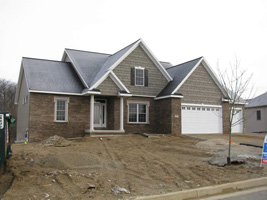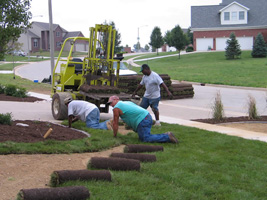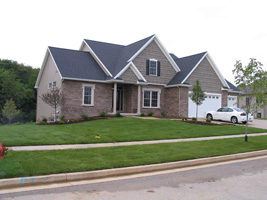Grieder Sod and Landscaping can take a yard that looks like this:
and with a little of our effort:
turn it into a beautiful yard like this:
and provide you with the knowledge or assistance to keep it this way.
View Sod Details and Pricing
Installation
- All areas to be sodded should be finish graded. Finish grade should be 1" below walks, drives and edging so sod will be flush.
- Edge all areas not bordered by drive, edging, walk, etc. with a row of sod to form a straight edge. In addition, it is easier to sod along the property line with a string line pulled.
- Start laying sod along a straight edge, such as a drive or walk. Lay sod rolls tight against each other, but do not overlap them. Trim off any excess with a sharp knife. The sod rolls should be laid with staggered joints.
- On excessive sloped, the sod should be laid perpendicular to the slope, so runoff won't form channels along the joints. It may also be necessary to peg the sod to the slope with small wooden stakes. The stakes should go at each corner and in the middle.
- As soon as an area large enough to sprinkle is laid, start watering and completely saturate the entire area. Water sod with a penetration of about 6". You cannot over water sod.
Note: under most circumstances, sod should be installed from the back of the property line working towards the street. This way, if miscalculation occurs, sod wont' have to be carried over freshly laid material.
Maintaining your Sodded Lawn
The First Year
During the months following establishment of a newly sodded lawn, proper watering and fertilizing will be very important.
The roots will be shallow and sod can dry out quickly. Daily watering is not necessary but two to three times per week may be needed during the hottest, driest part of the summer.
Approximately 30 days after installation the sod should be treated with organic based, slow release nitrogen fertilizers. It should be fertilized again in six to eight weeks. At this point the fertilization schedule can conform to a four step program of spring, early summer, late summer, and fall applications.
During this first season there may be a variety of broad leaf and grassy weeds that appear in the lawn. Weed seeds are abundant in the soil and can germinate and grow through the sod. We cannot apply a pre-emergent herbicide prior to sodding. The best way to inhibit weeds is to keep the sod healthy. Healthy grass will crowd out most weeds over time.
Broad leaf weeds can be spot sprayed after the sod has been mowed two or three times. Grassy weeds like yellow nut sedge (watergrass) and foxtail are common but are harder to control the first year. They usually die off as the lawn becomes more established. Most are annuals and will be killed with first frost of autumn. A pre-emergent herbicide can be used in the spring and will greatly reduce grassy weed populations.
General Lawn Care Tips
Mowing
Mow Lawn at 2.5" to 3" tall. A taller lawn will have better color, a more extensive root system, tolerate periods of heat and drought, and will have fewer weeds.
Do not remove more than 1/3 of the total leaf blade with each mowing. Cutting grass is stressful for the plant. Removing a little growth each time will help keep the plants healthy. Smaller clippings decompose faster too!
Leave clippings on the lawn. Small clippings are mostly water and will decompose quickly. The remaining tissue decomposes and returns nutrients and organic matter to the soil. If clippings form clumps and are unsightly - use a rake or blower to spread them throughout the lawn.
Keep mower blades sharp. Ideally your mower blade should be sharpened after every 8 to 10 hours of use. Dull blades can rip the leaves causing the grass to loose excessive amounts of water resulting in a dry, dull, yellow/tan look.
Alternate mowing directions to avoid patterns and ruts in the lawn.
Fertilization
Grieder Landscape Maintenance recommends two to four applications of fertilizer per year - ideally putting down up to 1 pound of nitrogen per 1,000 square feet per application. An organic-based, slow release nitrogen is best for gradual feeding throughout the growing season. Some organic based fertilizers can also help to rebuild the soil that is often damaged during the construction process or after years of chemical pesticide treatments. Spring fertilizer should include crabgrass preventer that will inhibit crabgrass, foxtail, and other weeds. Crabgrass germinates when the soil temperatures reach 55 degrees so don't get in a big hurry to apply your crabgrass preventer. Usually the mid to end of April is perfect timing.
Weed Control
Spot spray broad leaf weeds to keep them under control. Spring or fall, when they are actively growing, is the most effective time to spray. Mowing at 3" tall and proper fertilization will greatly reduce weed populations.
Aeration
Core aeration is an important component of maintaining a healthy lawn. Core aeration is usually done in spring and/or fall. During the construction process the soil becomes very compact and oxygen, water and nutrients can barely get into the soil. Core aeration removes small plugs of soil, breaking the soil surface to help relieve some of the compaction allowing for increased penetration of oxygen, water, and nutrients. Core aeration also breaks up thatch and the increased oxygen and moisture speeds up the decomposition rate of dead roots and leaves. Plugs 1" to 2.5" deep and 4" to 5" apart are ideal.
Grieder Landscape Maintenance provides professional lawn care services and "there is a difference!"
We continually research and choose the most effective products available. We monitor weather conditions and properly time all applications accordingly. Grieder Landscape Maintenance is committed to providing the quality lawn care you expect as well as improving our soils and protecting the environment. We use organic and natural products at safe but effective levels. Pesticides are used on a very limited basis.
We also offer a totally pesticide free lawn care program!
For more information contact our office - ask for Brian!
|
DESIGN CENTER HOURS MONDAY-FRIDAY
SATURDAY 9:00 A.M. - 4:00 P.M.
SUNDAY
|
1804 Towanda Barnes Road
Bloomington, IL 61705
309-662-8527

![]()
Looking for individuals to join our team!
Landscape Design/ Sales
We are looking for an outgoing, aggressive person with project management experience, hardscape knowledge and outstanding customer service skills. Must have a degree in Landscape Architecture/ Horticulture and a min. of 3 years strong experience in a landscape design/sales environment. Please send resume and references to [email protected]. All applicants will remain confidential.


















